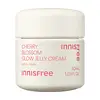What's inside
What's inside
 Key Ingredients
Key Ingredients

 Benefits
Benefits

 Concerns
Concerns

 Ingredients Side-by-side
Ingredients Side-by-side

Water
Skin ConditioningPropanediol
SolventDimethicone Crosspolymer
Emulsion StabilisingGlycerin
HumectantButylene Glycol
HumectantDicaprylyl Carbonate
EmollientLactococcus Ferment Lysate
Skin ConditioningPentylene Glycol
Skin ConditioningCetearyl Methicone
Skin ConditioningDimethicone
EmollientCaprylyl Methicone
Skin ConditioningCetearyl Alcohol
EmollientGlyceryl Stearate
EmollientPotassium Olivoyl Hydrolyzed Oat Protein
CleansingPyrus Malus Fruit Extract
Skin ConditioningSodium Polyacryloyldimethyl Taurate
Emulsion StabilisingHydroxyacetophenone
AntioxidantPhenoxyethanol
PreservativeXanthan Gum
EmulsifyingBeta Vulgaris Root Extract
Skin ConditioningFructooligosaccharides
HumectantMorinda Citrifolia Extract
AstringentAcrylates/C10-30 Alkyl Acrylate Crosspolymer
Emulsion StabilisingGlyceryl Oleate
EmollientCaprylic/Capric Triglyceride
MaskingHydrolyzed Hyaluronic Acid
HumectantNiacinamide
SmoothingOlea Europaea Fruit Unsaponifiables
AntioxidantSclerotium Gum
Emulsion StabilisingLecithin
EmollientPullulan
Ethylhexylglycerin
Skin ConditioningTetrasodium Glutamate Diacetate
Silica
AbrasiveLinoleic Acid
CleansingPhospholipids
Skin ConditioningPhytosterols
Skin ConditioningAloe Barbadensis Leaf Juice
Skin ConditioningCaramel
Cosmetic ColorantWater, Propanediol, Dimethicone Crosspolymer, Glycerin, Butylene Glycol, Dicaprylyl Carbonate, Lactococcus Ferment Lysate, Pentylene Glycol, Cetearyl Methicone, Dimethicone, Caprylyl Methicone, Cetearyl Alcohol, Glyceryl Stearate, Potassium Olivoyl Hydrolyzed Oat Protein, Pyrus Malus Fruit Extract, Sodium Polyacryloyldimethyl Taurate, Hydroxyacetophenone, Phenoxyethanol, Xanthan Gum, Beta Vulgaris Root Extract, Fructooligosaccharides, Morinda Citrifolia Extract, Acrylates/C10-30 Alkyl Acrylate Crosspolymer, Glyceryl Oleate, Caprylic/Capric Triglyceride, Hydrolyzed Hyaluronic Acid, Niacinamide, Olea Europaea Fruit Unsaponifiables, Sclerotium Gum, Lecithin, Pullulan, Ethylhexylglycerin, Tetrasodium Glutamate Diacetate, Silica, Linoleic Acid, Phospholipids, Phytosterols, Aloe Barbadensis Leaf Juice, Caramel
Water
Skin ConditioningGlycerin
HumectantPropanediol
SolventDipropylene Glycol
HumectantNiacinamide
SmoothingBetaine
Humectant1,2-Hexanediol
Skin ConditioningCarbomer
Emulsion StabilisingTromethamine
BufferingSodium Metaphosphate
BufferingAmmonium Acryloyldimethyltaurate/Beheneth-25 Methacrylate Crosspolymer
Emulsion StabilisingEthylhexylglycerin
Skin ConditioningParfum
MaskingPrunus Yedoensis Leaf Extract
Skin ConditioningTocopherol
Antioxidant
 Reviews
Reviews

Ingredients Explained
These ingredients are found in both products.
Ingredients higher up in an ingredient list are typically present in a larger amount.
Ethylhexylglycerin (we can't pronounce this either) is commonly used as a preservative and skin softener. It is derived from glyceryl.
You might see Ethylhexylglycerin often paired with other preservatives such as phenoxyethanol. Ethylhexylglycerin has been found to increase the effectiveness of these other preservatives.
Glycerin is already naturally found in your skin. It helps moisturize and protect your skin.
A study from 2016 found glycerin to be more effective as a humectant than AHAs and hyaluronic acid.
As a humectant, it helps the skin stay hydrated by pulling moisture to your skin. The low molecular weight of glycerin allows it to pull moisture into the deeper layers of your skin.
Hydrated skin improves your skin barrier; Your skin barrier helps protect against irritants and bacteria.
Glycerin has also been found to have antimicrobial and antiviral properties. Due to these properties, glycerin is often used in wound and burn treatments.
In cosmetics, glycerin is usually derived from plants such as soybean or palm. However, it can also be sourced from animals, such as tallow or animal fat.
This ingredient is organic, colorless, odorless, and non-toxic.
Glycerin is the name for this ingredient in American English. British English uses Glycerol/Glycerine.
Learn more about GlycerinNiacinamide is a multitasking form of vitamin B3 that strengthens the skin barrier, reduces pores and dark spots, regulates oil, and improves signs of aging.
And the best part? It's gentle and well-tolerated by most skin types, including sensitive and reactive skin.
You might have heard of "niacin flush", or the reddening of skin that causes itchiness. Niacinamide has not been found to cause this.
In very rare cases, some individuals may not be able to tolerate niacinamide at all or experience an allergic reaction to it.
If you are experiencing flaking, irritation, and dryness with this ingredient, be sure to double check all your products as this ingredient can be found in all categories of skincare.
When incorporating niacinamide into your routine, look out for concentration amounts. Typically, 5% niacinamide provides benefits such as fading dark spots. However, if you have sensitive skin, it is better to begin with a smaller concentration.
When you apply niacinamide to your skin, your body converts it into nicotinamide adenine dinucleotide (NAD). NAD is an essential coenzyme that is already found in your cells as "fuel" and powers countless biological processes.
In your skin, NAD helps repair cell damage, produce new healthy cells, support collagen production, strengthen the skin barrier, and fight environmental stressors (like UV and pollution).
Our natural NAD levels start to decline with age, leading to slower skin repair, visible aging, and a weaker skin barrier. By providing your skin niacinamide, you're recharging your skin's NAD levels. This leads to stronger, healthier, and younger looking skin.
Another name for vitamin B3 is nicotinamide. This vitamin is water-soluble and our bodies don't store it. We obtain Vitamin B3 from either food or skincare. Meat, fish, wheat, yeast, and leafy greens contain vitamin B3.
The type of niacinamide used in skincare is synthetically created.
Learn more about NiacinamidePropanediol is an all-star ingredient. It softens, hydrates, and smooths the skin.
It’s often used to:
Propanediol is not likely to cause sensitivity and considered safe to use. It is derived from corn or petroleum with a clear color and no scent.
Learn more about PropanediolWater. It's the most common cosmetic ingredient of all. You'll usually see it at the top of ingredient lists, meaning that it makes up the largest part of the product.
So why is it so popular? Water most often acts as a solvent - this means that it helps dissolve other ingredients into the formulation.
You'll also recognize water as that liquid we all need to stay alive. If you see this, drink a glass of water. Stay hydrated!
Learn more about Water